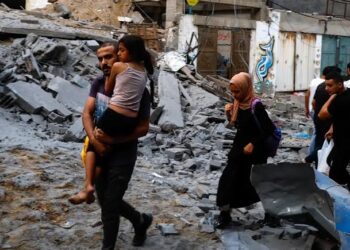The number of dead, injured, and displaced Palestinians continues to grow as Israel intensifies its attacks on Hamas. On Monday, Israel bombed the southern and central Gaza Strip, following a weekend strike targeting Hamas leaders, which killed many Palestinians who had taken refuge in a makeshift camp.
Displaced Survivors
This recent attack happened two days after the weekend strike that turned a crowded area in Mawasi, near the Mediterranean coast, into a wasteland, displaced survivors were left with no idea where to go next. Mawasi, on the outskirts of Khan Younis, had been a shelter for hundreds of thousands of Palestinians after Israel declared it a safe zone. Israel said the strike was aimed at Hamas military commander Mohammed Deif, responsible for the October 7 attacks on Israeli towns, which led to the Gaza conflict.

Impact on Mawasi
The Israeli military claimed they targeted an open area with buildings and sheds run by Hamas, not a tented camp. Palestinian officials reported at least 90 people killed and many wounded in the Saturday strike.
Continued Fighting in Rafah
In Rafah, which has been the main focus of Israel’s recent advances, renewed fighting was reported on Monday. Israeli forces blew up several homes, and medical officials recovered 10 Palestinian bodies in the city’s eastern areas. The military also increased shelling in central Gaza, specifically in the Al-Bureij and Al-Maghazi refugee camps. Health officials reported five Palestinians were killed in an airstrike on a house in Maghazi camp.
The Israeli military also stated that its air forces struck many Palestinian military targets, killing numerous gunmen in close combat which occurred in Rafah and central Gaza.
Ceasefire Negotiations
The deadly strike in Mawasi overshadowed ceasefire negotiations that were previously described as close to a resolution. However, a senior Hamas official said the group had not abandoned the talks despite the strikes on Saturday. Israel claimed another senior commander was killed in the strike but has not confirmed Deif’s fate. Hamas denied Deif was killed.
Environmental Impact
According to the United Nations Environment Programme, clearing the 40 million tons of war rubble in Gaza could take 15 years, requiring over 100 trucks and costing more than $500 million. The debris poses a deadly threat due to possible unexploded ordnance and harmful substances.
Bottom Line
The ongoing conflict in Gaza continues to result in high casualties and widespread displacement. Efforts towards a ceasefire remain uncertain, while the environmental impact of the destruction presents long-term challenges for recovery and safety.















